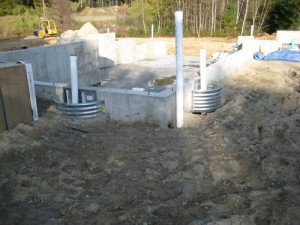Installing Foundation Window Wells
Window Well Installation
 Installing window wells is a very good way of preventing unwanted water from entering into your basement windows. Window wells also allow the finish grade to be brought to an elevation higher than the window while still letting light into the window.
Installing window wells is a very good way of preventing unwanted water from entering into your basement windows. Window wells also allow the finish grade to be brought to an elevation higher than the window while still letting light into the window.
How To Install Window Wells
Window well installation is fairly easy for new construction and not all that more complicated for existing buildings. Window wells help keep sufficient grade separation around foundation windows. They should be properly drained to prevent basement flooding during wet periods. The following directions apply to both new and existing construction.
Set Window Well Elevation
First you’ll need to set an elevation for the window wells. I like to set the top of the window well at least 2 to 3 inches above finished grade. This ensures that water and debris don’t fall into the finished window well. It’s very important that the finished grade be no closer to the house siding than 8 or 9 inches. Therefore you’ll want to set the top of window well about 6 inches down from the siding.
Dig / Excavate For Window Wells
You’ll need to dig a hole twice the size and depth of the window well. Also, you should excavate a trench for a drainage pipe from the base of the window well out to “daylight” or connect it to a properly drained foundation drain. Once the drainage pipe is installed I like to install clean pea stone at least 12 inches deep below the base of the window well. You can also fill the bottom of the window well with a couple inches of stone as well.
Window Well Drainage
Window well installation must be properly drained or you risk having water run into your basement through the foundation windows during a rain event. The best way to drain window wells is to install a foundation drain with positive pitch (1% minimum) from the base of the window well to a location on your property that allows the drain to “daylight” and drain out onto the ground.
Sometimes it’s necessary to drain the window wells to the foundation drains (if they are properly drained to daylight) or you may need to connect them to a stone under-drain. At any rate this is extremely important and a step that must not be skipped.
Attach Window Wells To Foundation Walls
As you can see in the photo window wells have been installed at each foundation window. The window wells are fabricated from a heavy gauge galvanized steel. The window wells have mounting holes pre-drilled on each side. To install them we use TAPCON SLOTTED HEX HEAD MASONRY ANCHORS to attach the window wells to the concrete foundation wall. Once the window wells are attached to the concrete wall the ground can be back-filled in front of them.
That’s all there is to installing a window well. In the winter you may want to purchase Window Well Covers to keep snow and ice out of the window wells.














I have a basement window well with a custom fitted cover. Its takes on water from the sides of the window well. Is there anything that I can use as a caulk to stop the water from coming into the window well and possibly going thru the window and flooding the basement? there is a drain in the bottom of the window well but it fills up pretty quickly. Thank you!
GBeck – Where is the water coming in? From the cover?
I had the same problem with my window well. I tried caulking inside the window well with concrete caulk, and getting a nice seal around the cover, but water always found a way in (I have a drain at the bottom as well). I ended up having to remove the grass 9 feet out from around the window well and grading the yard better. I also put in a 10 gal drywell underground about 6 feet out from the window well so the water would take a different route.
The pea stones should be at least 12 inches deep. However, should the stones be level with, or below the level of the bottom of the window?
If below the level of the bottom of the window, how far below. I have seen window wells with the stones up to the bottom of the window frame, others with stones 4 to 6 inches below that level.
Thanks for your help.
Definitely below the window, at least 6 inches, more if possible.
Do I want to caulk between concrete wall and window well?
Yes sir.
Hi. Other than faster, why do you use Tapcon screws instead of sleeve anchors? I assume it is because there isn’t much to hold since the weight of the dirt also keeps them in place? Thanks.
Honestly, I prefer Tapcon fasteners to sleeve fasteners. They work much better, and the new structural rated ones are amazing.
What should I expect to be charged to have new wells put in. Have no idea what labor cost would be fair? My wells have rusted and dirt is breaking through. The window is fine.
Get multiple estimates, each situation is different.
On your “Installing Foundation Window Wells”, you said you liked TapCon fasteners. Your installation was done on a “poured” foundation.
What about an older home with a building block foundation? Do you still prefer the TapCon fasteners?
What type of caulk do you recommend for sealing the galvanized well to the block wall after the fasteners have been installed?